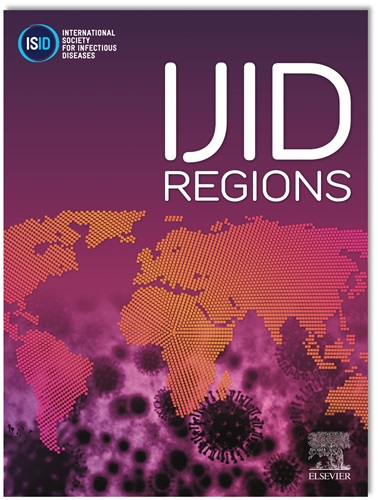Global and regional burden of bloodstream infections caused by carbapenem-resistant Gram-negative bacteria in 2019: A systematic analysis from the MICROBE database
IF 4.8
2区 医学
Q1 INFECTIOUS DISEASES
引用次数: 0
Abstract
Objectives
To quantify the global and regional burden of bloodstream infections associated with and attributable to carbapenem-resistant Gram-negative bacteria.
Methods
We extracted data from the Measuring Infectious Causes and Resistance Outcomes for Burden Estimation database, which includes the estimated burden of 23 pathogens and 88 pathogen-drug combinations across 12 major infectious syndromes globally in 2019. The number and rate of deaths, as well as disability-adjusted life-years linked to bloodstream infections, were systematically analyzed.
Results
In 2019, bloodstream infections accounted for approximately 2.91 (95% UI, 1.74-4.53) million deaths globally, with Gram-negative bacteria responsible for 51.1% of these fatalities. An estimated 391,800 (95% UI 221,500-631,400) deaths were associated with carbapenem resistance, constituting 26.3% of all bloodstream infection-related deaths. The highest burden of carbapenem resistance was seen in South Asia, East Asia, and Eastern Europe, while the lowest burden was in Sub-Saharan Africa. Notably, Acinetobacter baumannii, Klebsiella pneumoniae, and Pseudomonas aeruginosa were the leading carbapenem-resistant pathogens contributing to mortality.
Conclusions
Our findings underscore the significant global burden of bloodstream infections caused by carbapenem-resistant Gram-negative bacteria, with notable regional disparities. There is an urgent need for enhanced surveillance, improved infection prevention and control measures, and better access to first-line antibiotics, particularly in high-burden regions.
2019年碳青霉烯耐药革兰氏阴性菌引起的全球和区域血液感染负担:来自微生物数据库的系统分析
目的:量化与碳青霉烯耐药革兰氏阴性菌相关的血流感染的全球和区域负担。方法:我们从微生物数据库中提取数据,其中包括2019年全球12种主要感染综合征的23种病原体和88种病原体-药物组合的估计负担。系统地分析了死亡人数和死亡率,以及与血液感染相关的残疾调整寿命年。结果:2019年,全球血液感染死亡人数约为2.91万人(95% UI, 174 - 453),其中革兰氏阴性菌占51.1%。估计有391,800例(95% UI 221,500-631,400)死亡与碳青霉烯类耐药性有关,占所有血液感染相关死亡的26.3%。碳青霉烯耐药负担最重的是南亚、东亚和东欧,而负担最低的是撒哈拉以南非洲。值得注意的是,鲍曼不动杆菌、肺炎克雷伯菌和铜绿假单胞菌是导致死亡的主要碳青霉烯耐药病原体。结论:我们的研究结果强调了碳青霉烯耐药革兰氏阴性菌引起的血流感染的重大全球负担,且存在显著的区域差异。迫切需要加强监测,改进感染预防和控制措施,更好地获得一线抗生素,特别是在高负担地区。
本文章由计算机程序翻译,如有差异,请以英文原文为准。
求助全文
约1分钟内获得全文
求助全文
来源期刊
CiteScore
18.90
自引率
2.40%
发文量
1020
审稿时长
30 days
期刊介绍:
International Journal of Infectious Diseases (IJID)
Publisher: International Society for Infectious Diseases
Publication Frequency: Monthly
Type: Peer-reviewed, Open Access
Scope:
Publishes original clinical and laboratory-based research.
Reports clinical trials, reviews, and some case reports.
Focuses on epidemiology, clinical diagnosis, treatment, and control of infectious diseases.
Emphasizes diseases common in under-resourced countries.

 求助内容:
求助内容: 应助结果提醒方式:
应助结果提醒方式:


